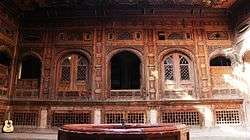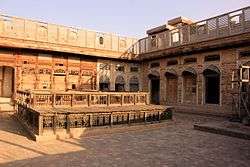Sethi Mohallah
Sethi Mohallah (Urdu: سیٹھی محلہ), sometimes called Sethian Mohallah, is an old and traditionally arranged neighbourhood in the old city of Peshawar, Pakistan. The mohallah contains seven South Asian mansions built by the Sethi family that were built in a style reminiscent of Central Asia with elaborate wooden carvings. The houses were completed in the late 19th century.[1]
Sethi Mohallah سیٹھی محلہ | |
|---|---|
 The Sethi Mohallah is famous for its Central-Asian style homes. | |
| Country | Pakistan |
| Province | Khyber Pakhtunkhwa |
| City | Peshawar |
Background

The Sethis were traders who had businesses in China, India, Afghanistan, Iran and Central Asia, with trade centres at Mazar Sharif, Tashkent, Bukhara, Samarqand and other cities in the Asian region. The Sethi family was involved in considerable welfare work in Peshawar and had contributed to the construction of wells for the poor, along with the Lady Reading Hospital and the Islamia College Mosque.[2]
The downfall of the Sethis began during the Russian Revolution in 1917, when their businesses experienced setbacks from which they never recovered, forcing them to leave Central Asia and return to Peshawar.[1]
Location
It is situated close to the Ghanta Ghar (clock tower), Bazaar Kalan and Gor Khuttree in Peshawar's old walled city.
Design
The homes were designed with inspiration from the vernacular architecture of Bukhara. Two neatly decorated tehkhanas (basement rooms), a balakhana (upper storey), dalaans (big halls), chinikhanas (rooms where decoration and art pieces are displayed on chimneypieces) and fountains can be found in each house. The ceilings are painted and the walls are decorated with mirror work. One of the houses has been purchased by the NWFP government, this house has two portions, one for men and one for women. The overall structure is a combination of brick and woodwork embellished with carved wooden doors and balconies. Painted and mirrored atriums provide fresh air and attractive views, while the main entrances are made of superbly carved wood.
It has 12 rooms and four basements and includes a fountain. Colourful glass ceilings with geometrical designs, woodwork with engravings of various splendid designs on walls, a big resting place, made of wood and called Takht-e-Sulaimani, to take sunshine in winter, beautiful ventilators, slanting window-shades, wooden wall cupboards, chimneys and red bricks stairs with projected wooden frames are some of the prominent features of the house.
Gallery

 Most homes contain an inner courtyard.
Most homes contain an inner courtyard. Some of the homes are open to visitors.
Some of the homes are open to visitors. A view of the courtyard of one the Sethi Mohallah's homes
A view of the courtyard of one the Sethi Mohallah's homes The mohallah is known for the intricate wood-carvings that decorate its homes.
The mohallah is known for the intricate wood-carvings that decorate its homes. Some homes feature brick pillars.
Some homes feature brick pillars. A plaque with religious verses at one of the homes
A plaque with religious verses at one of the homes The view of a home's second floor
The view of a home's second floor Some homes feature stained-glass windows.
Some homes feature stained-glass windows. Wooden railings on a rooftop
Wooden railings on a rooftop Carved niches on a rooftop
Carved niches on a rooftop- Ceilings in the homes are also decorated.


.jpg)
References
External links
- Pictures of Mohallah Sethian Sarhad Conservation Network
- Sarhad Tourism Corporation, Government of Khyber Pakhtunkhwa
